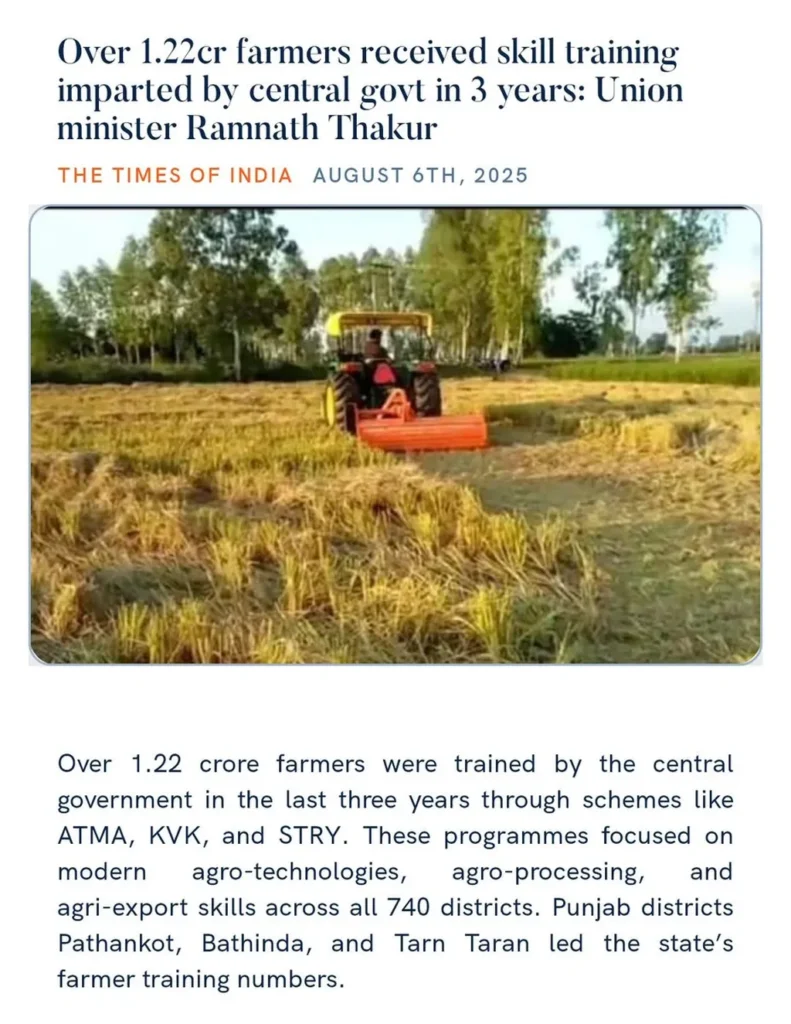The Government of India’s push to strengthen farmer capacities through structured skill development is yielding measurable results, with training programmes reaching millions of cultivators and rural youth over the past four years. Data released by the Press Information Bureau (PIB) on September 30, 2025, highlights how institutional platforms like Krishi Vigyan Kendras (KVKs), the Agricultural Technology Management Agency (ATMA), and sector-specific missions are systematically equipping farmers with technical knowledge, market linkages, and adaptive strategies to navigate modern agricultural challenges.
At the forefront of this effort are the KVKs, which have emerged as the most accessible training hubs for farmers. Between 2021 and early 2025, these centres—operating under the Indian Council of Agricultural Research (ICAR)—trained over 58 lakh farmers, with annual participation growing from 16.91 lakh in 2021–22 to 21.56 lakh in 2023–24. The training modules, tailored to local agro-climatic conditions, cover critical areas such as climate-resilient farming, soil health management, and post-harvest technologies. This hands-on approach ensures that scientific advancements are not confined to research labs but are adopted in fields, directly influencing productivity and sustainability.
Complementing the KVKs, the ATMA scheme has revitalized state-level extension systems by decentralizing farmer training. Through demonstrations, exposure visits, and *kisan melas*, ATMA reached over 1.27 crore farmers between 2021 and January 2025. The scheme’s focus on thematic training—ranging from organic farming to digital agriculture—has helped bridge the gap between traditional practices and modern techniques. For instance, in 2023–24 alone, ATMA conducted training for 36.6 lakh farmers, reinforcing its role as a key driver of agricultural extension reforms.
A notable shift in recent years has been the emphasis on skilling rural youth, recognizing their potential to transform agriculture through innovation and entrepreneurship. The Skill Training of Rural Youth (STRY) programme, now integrated with ATMA, has trained over 43,000 young farmers since 2021, with courses in horticulture, dairy management, and agri-mechanization. Similarly, the Sub-Mission on Agricultural Mechanization (SMAM) has trained 57,139 farmers in operating and maintaining farm machinery, addressing the dual challenges of labor shortages and high equipment costs. By promoting custom hiring services and demonstrations, SMAM is making mechanization accessible to smallholders, who constitute the majority of India’s farming community.
Beyond crop cultivation, the government’s skill development initiatives are increasingly targeting allied sectors where value addition can significantly boost incomes. The Soil Health Card Scheme, for example, has distributed over 25 crore cards since its launch, accompanied by 93,000 training sessions on nutrient management. Farmers are now better equipped to interpret soil data, optimize fertilizer use, and adopt sustainable practices—critical steps in reversing land degradation and reducing input costs.
The formation of 10,000 Farmer Producer Organizations (FPOs) has further institutionalized capacity building, with digital training modules on agri-business, market intelligence, and e-commerce platforms like e-NAM. This collective approach not only enhances bargaining power but also exposes farmers to global best practices in supply chain management. Meanwhile, the Pradhan Mantri Kaushal Vikas Yojana (PMKVY 4.0) has certified over 1.29 crore individuals in agriculture-related skills since 2015, integrating the sector into the national skilling ecosystem.
Sector-specific missions are reinforcing these efforts. The Mission for Integrated Development of Horticulture (MIDH) has trained nearly 10 lakh farmers in high-value crop production, while the Rashtriya Gokul Mission (RGM) is upskilling livestock farmers in breed improvement and dairy management. Such targeted interventions ensure that skilling aligns with market demands, whether in export-oriented horticulture or the growing dairy industry.
The implications of this multi-pronged approach are far-reaching. For farmers, enhanced skills translate to better risk management, higher yields, and diversified income streams. For the agricultural sector, a skilled workforce is essential to adopting technology, improving resource efficiency, and meeting the demands of a changing climate. Perhaps most importantly, these programmes are fostering a cultural shift—from viewing farming as a subsistence activity to recognizing it as a dynamic, skill-intensive profession.
As these initiatives scale up, the challenge will lie in ensuring last-mile delivery, particularly for women and marginal farmers who often face barriers to access. The integration of digital tools, such as mobile-based

